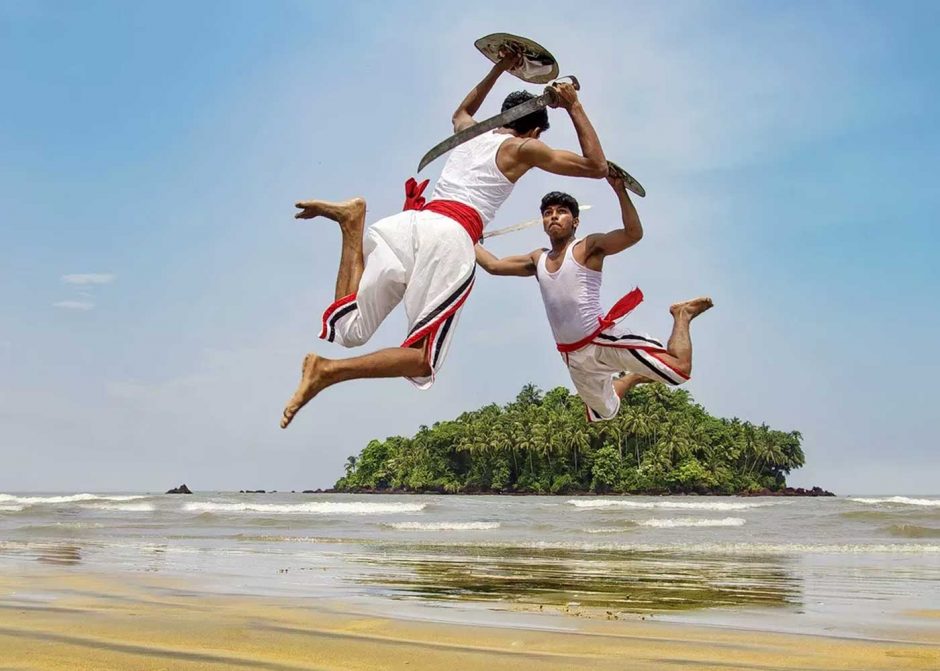What first comes to mind when you think of India?
Colorful festivals, spicy food, the Himalayan Mountains, the Ganges River, the Taj Mahal, Bollywood, cricket, Jaipur, tropical climate, Ayurveda, yoga, Mahatma Gandhi, Mother Theresa, Nirvana, Hinduism, Buddhism …. The list is endless.
And yet, one of India’s greatest marvels by far happens to be a form of intangible cultural heritage least known to the Western world: Kalaripayattu.
Its philosophy is best expressed in a definition by www.pitzee.com, paraphrased below:
Master your body to make strength, flexibility and endurance part of your nature; master speed to move faster than the enemy’s eyes can see; master the weapon to make it an extension of your own limbs. Work on yourself, not seeking victory, revenge, wealth or honor. Instead, see the path – the endless pursuit of self-perfection – as the goal, for this is Kalaripayattu.
A practice that originated in Kerala, South India over six thousand years ago, Kalaripayattu (kalari meaning training ground and payattu, combat) is both a martial art and a way of life consisting of five interrelated parts – fighting, healing (Ayurveda), yoga, astrology and spiritual practice, none of which can exist or develop in isolation of the others.
Introduced by Lord Parashurama, an avatar of the Hindu God Vishnu, Kalari, as the martial art is also known, combined the basic principles of psychology and physiology with the purpose of developing the whole person.
Forming an integral part of the region’s socio-political system, Kalaripayattu was originally a secret fighting method of medieval Kerala’s warrior caste, the Nairs, with intense training in physical discipline, armed and unarmed combat, breathing, meditation and healing treatments. According to early scriptures, it spread beyond India in the 6th century AD when a wandering monk, Bodhidharma, introduced it to his Chinese brethren, laying the foundation for Asian martial arts. Shaolin Kung Fu and Karate are but two of the forms that evolved from it.
This ancient tradition is still practiced today, passed down from guru to student, with its distinct style and code of ethics informed by Kerala’s unique culture, history and geography. Kalaripayattu’s actual movements and techniques originated from observing the habits of eight “warrior” animals that inhabited the region: the lion, boar, cobra, elephant, tiger, horse, rooster and buffalo. Each represented a distinct pose or stance with its corresponding style, function and power.
Though the deadliest fighting system in the world – and possibly because it is – this mother of all martial arts is also the most principled, as its teachings were and remain strictly intended for self-defense and healing, a reminder of the fact that with knowledge and strength comes responsibility. To this day, Kalari masters assess whether you are worthy of learning its most lethal techniques based on your character, behavior and intentions in order to prevent its knowledge and power from being misused.
It is claimed that skilled Kalaripayattu warriors can disable or kill their opponents simply by touching the correct marmam (vital point) of the 107 identified and defined by Sushruta (circa 6th century BC), 64 of which were classified as lethal if struck properly with a fist or weapon. Nonetheless, the goal of Kalaripayattu is not the acquisition of power through the ability to cure or kill; but rather self-improvement or self-perfection, regarded as a reward in and of itself, yet without the belts, awards or alternative forms of recognition that are bestowed in the other martial arts. It is a supreme example of the human spirit in its purest form.
Today, the practice of Kalarippayattu has become more about how to harness one’s body-mind powers in order to craft an ideal self than how to prepare for mortal combat. Yet, some of today’s greatest masters still expect students to live by its moral code and ascetic dictates, resisting those temptations of modern life that corrupt the soul, such as drugs, alcohol and excess..
What other form of cultural expression can claim to cure and kill or harm and heal with the opposite sides of the same hand, simultaneously making an art of peace through war and a reward of self-improvement through the godlike transcendence of one’s physical limitations — all with the grace and beauty of a dancer? Make a pilgrimage to Kerala to find out more about Kalaripayattu, the oldest, noblest and most exquisite of martial arts.


I’m also madly interested in Learning marshal arts
I want to jo8n this academy so what is your process ?
When & how can i join the academy
Where is the academy in kerela
Great….I am proud of my India ….can girls join this academy?
I like it
Thank you
Give me address of academy of martial arts in kerala
sir
Martial Art sikhna hai sir
Hm waha aana chahte h, hmare liye bahut jyada Imp h, pls btaiye krna hoga, pls
Sir I want join kalaripattu classes, sir please send all detail.